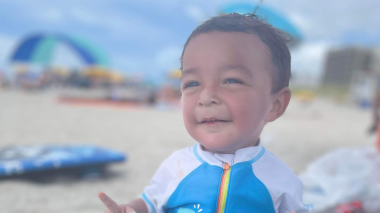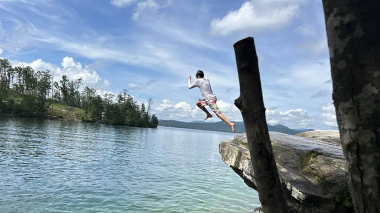When we think about strokes, we usually think of older adults. Even though pediatric stroke is rare, it can happen. Babies and children can have strokes, too: Each year, about 25 in 100,000 newborns and about 12 in 100,000 children younger than 18 will have a stroke. Because many people don’t expect a baby or child to experience a stroke, they may miss the signs. And just like with adults, every minute that separates a stroke and its treatment can raise the odds of lifelong ramifications.
That’s why Atrium Health Levine Children’s has created a new protocol for children and babies who have strokes. No matter which Atrium Health hospital the child visits, this protocol quickly connects all necessary departments to ensure that patients receive the correct stroke treatments in the fastest amount of time from a team of specialists. No other hospital system in the Charlotte area has a program like it.
“This new system can make a lifetime of difference to a child, who can recover from a stroke with minimal or no lasting effects. It can mean the difference between a life of disability and one that is totally healthy,” says Andrew Herman, MD, Chief Medical Officer of Levine Children’s Hospital and Jeff Gordon Children’s Center.
His teammates at Atrium Health – across specialties, hospitals and even counties – were fully committed to undertaking this work to improve stroke protocol for children, as was Carolina Neurosurgery & Spine Associates (CNSA), who partnered in the program.
The new stroke protocol began in early 2021, and during its first year, three children went through it at Levine Children’s. All have done remarkably well, returning home with no lasting effects. The number of children who’ve needed this protocol have been fortunately few, but the benefit is immeasurable: Three lifetimes, forever changed, have proven the power of this program.
Raising Awareness of Pediatric Stroke
Although pediatric stroke is rare, awareness is important so that parents and caregivers can recognize its warning signs and seek treatment as quickly as possible.
“People can have strokes at any time throughout their lives, beginning even in utero, oftentimes for reasons that are not completely understood,” says Daniel Bonthius, MD, PhD, medical director of pediatric neurology at Levine Children’s. “With stroke, time is brain. If you see a child or adult who you suspect has had a stroke, you need to get them to an emergency department or a physician as quickly as possible.”
With this protocol, pediatric stroke specialists collaborate instantly across locations through virtual tools. The system streamlines the process to give patients the fast imaging and interventions needed to eliminate or drastically reduce lasting effects.
A child who arrives at an Atrium Health hospital with symptoms of a stroke will be evaluated by a neurologist, either in person or virtually. Radiologists will conduct imaging. If a stroke intervention is needed, interventional radiologists, intensive care and emergency medicine physicians and neurosurgeons can treat the child. Afterwards, long-term rehabilitation may begin. The team works seamlessly together across specialties to advance the child through the steps needed to be diagnosed, treated and rehabilitated as quickly and fully as possible.
This program had a personal beginning. Several years ago, a child of a family friend of Dr. Herman’s had a stroke. He visited the child each day in the hospital, and Dr. Herman was relieved to see the child recover fully. The experience showed him how high the stakes are for pediatric stroke and how powerful a program like this would be. He approached Lauren Macko, MSN, APRN, clinical nurse specialist with Atrium Health Neurosciences Institute, to launch the program. Macko had just returned from maternity leave, and she was inspired to design a protocol that she’d want for her own baby.
“The incidence of stroke in children is much smaller than it is in adults. This is good, but low-volume, high-risk situations can be less streamlined,” Macko says. She reached out to Joe Bernard, MD, co-medical director of the cerebrovascular division at Atrium Health Neurosciences Institute and a neurosurgeon with CNSA, who became a close ally in her work to design the new protocol with the involvement of a multidisciplinary team. “When we had our first patient go through the entire process in early 2021, we saw the difference that it made. We saw how we were doing the right thing for that patient. The patient went home without any deficits, and that’s amazing.”
“I’ve never seen a group come together quite like this,” Dr. Herman says.
Changing the Course of a Child’s Life
Pediatric stroke can create a lifetime of deficits, such as paralysis, coordination problems, difficulty with language, cognitive deficits and behavioral problems. A timely intervention can mean a lifetime of difference. Therefore, it’s crucial for parents and caregivers to recognize the signs and understand the causes of pediatric stroke.
Causes of pediatric stroke include congenital heart disease, trauma to the head or neck, infection and clotting disorders. COVID-19 can cause stroke in children as well. Symptoms appear like those in adults: sudden onset of weakness on one side of the body, sudden lack of coordination or balance, seizure and sudden inability to speak or understand language.
“If you see something unusual, get help. Our process makes us a one-stop shop for all neurological needs. Even if it’s not a stroke, we can get your child to see the specialists they need to get the care they require,” Macko says. “We prefer overacting to underacting. This could have lifelong consequences for a child. It’s better for everyone’s peace of mind to bring a child in to get scanned, especially if it’s within 24 hours of the event.”
While it’s uncommon for a child to come to the hospital with a stroke, quick actions can make all the difference for children who do.
“We have the opportunity to eliminate stroke as a life changer for these kids, just by doing the things that we’ve already done but bringing departments together in an even more efficient way,” Dr. Herman says. He thinks often of his family friend and how difficult it was to see a child affected by a stroke, and how inspiring it was to watch him recover. “We’re talking about the rest of a child’s life, and we all have come together to do the right thing for these children.”
Learn more about the pediatric neurology and neurosurgery program at Atrium Health Levine Children's, ranked among the best nationwide by U.S. News & World Report.



